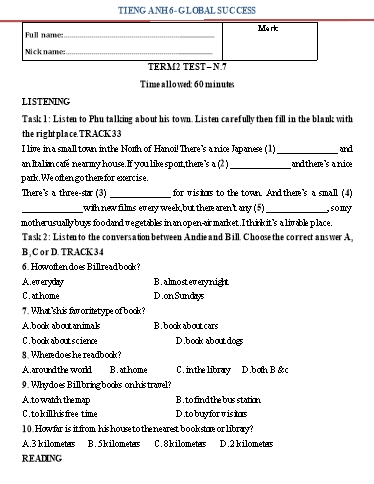Đề kiểm tra cuối kì 2 Tiếng Anh Lớp 6 Global Success - Đề N.7 (Có ma trận, file nghe và đáp án)
Bạn đang xem tài liệu "Đề kiểm tra cuối kì 2 Tiếng Anh Lớp 6 Global Success - Đề N.7 (Có ma trận, file nghe và đáp án)", để tải tài liệu gốc về máy hãy click vào nút Download ở trên.
Tóm tắt nội dung tài liệu: Đề kiểm tra cuối kì 2 Tiếng Anh Lớp 6 Global Success - Đề N.7 (Có ma trận, file nghe và đáp án)

TIENG ANH 6- GLOBAL SUCCESS Read the text about Olivia’s school and answer these questions. My Mum Is My Teacher! My name is Olivia. It’s 9.30 on Tuesday morning and I’m sudying, but I’m not at school that’s because I’m home- educated. All children in Britain between five and eighteen must have an education. This is usually at school, but it can be at home. School is boring for me because the lessons are really easy, so I stay at home and my mum teaches me. I study the same subjects as students at school, but I can learn at my level. I’m really good at Maths, so I can take my Maths GCSE in May. People take that exam when they are fifteen or sixteen, but I’m only twelve. I usually study for five hours a day. I don’t wear uniform. There is a computer in my “classroom” and I do a lot of work using DVDs and the internet. I practise the violin every day and I play in an orchestra once a week. I love learning at home. I haven’t got any brothers or sisters, but I’m never lonely. I go to a sport club at the weekends and 1 have got many friends. Some of them also study at home, so we sometimes chat online. GCSE: General Certificate of Secondary Education 11. Why doesn’t Olivia go to school? _____________________________________________________________________________ 12. Who teaches Olivia at home? _____________________________________________________________________________ 13. At what age do students usually take GCSE in Britain? _____________________________________________________________________________ 14. Why does she think the school is boring? _____________________________________________________________________________ 15. How many hours a day does she study? _____________________________________________________________________________ Read the text and decide the sentences are true (T) or false (F). I live in a small village called Henfield. There are about 500 people here. The village is quiet and life here is slow and easy. You never have to queue in shops or banks. People never throw TIENG ANH 6- GLOBAL SUCCESS 28. Massey university is a ____________ school with 1000 students. A. medium-sized B. sized-medium C. oversized D. middle Mark the letter A, B, C or D to indicate the word whose underlined part differs from the other three in pronunciation in each of the following questions. 29. A. repeats B. classmates C. amuses D. attacks 30. A. crocodile B. animal C. fish D. milk WRITING Rearrange the words to make meaningful sentences. 31. something/ to/ you/ Would/ drink/ like/? _____________________________________________________________________________ _____ 32. the post office/ is/ the/ opposite/ bookshop/. _____________________________________________________________________________ _____ 33. I/old/ like/ places/ because/ are/ usually/ they/ quiet/ and/ peaceful. _____________________________________________________________________________ _____ 34. can/ pass/ please/ some milk,/ you/ me/? _____________________________________________________________________________ _____ 35. to school/ your/ bicycle/ ride/ you/ do/? _____________________________________________________________________________ _____ Write a short paragraph to describe a place of interest in your village/ town/ city. Use these notes. (36-40) Name of natural place Where is it? How far is it? How can you get there? What is it like? TIENG ANH 6- GLOBAL SUCCESS a. Use the words given below to make questions. Ask your friend about his/her picture and listen to the answers. 1. Who/you/see/picture? 2. What/they/do? 3. How/may feel? 4. What/picture/tell you? 5. Do/you/like/activity? Why/Why not? b. Now, your friend will ask you questions about your picture. Answer his/her questions. CARD B a. Now, your friend will ask you questions about your picture. Answer his/her questions. b. Use the words given below to make questions. Ask your friend about his/her picture and listen to the answers. 1. Who/you/see/picture? 2. What/she/do?
File đính kèm:
 de_kiem_tra_cuoi_ki_2_tieng_anh_lop_6_global_success_de_n_7.docx
de_kiem_tra_cuoi_ki_2_tieng_anh_lop_6_global_success_de_n_7.docx 6.2. Bộ đề.đá.pdf
6.2. Bộ đề.đá.pdf Track 33.mp3
Track 33.mp3 Track 34.mp3
Track 34.mp3

